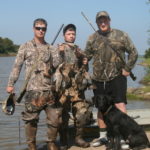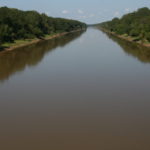
It was likely an earthquake that formed this flat, expansive lake, and tumult has been its hallmark throughout its existence.
Every Louisiana sportsman has heard of Catahoula Lake, the duck hunting mecca in east-central Louisiana, but they might not know what a rich and sometimes violent history it has.
Catahoula is a depression lake that was created when seismic activity, such as an earthquake, caused the land to sink, and Little River filled up the depression with water. Typical of depression lakes, it covers a vast area (about 26,000 acres), but is fairly shallow.
It is not known when the lake was formed, but seismic disturbances have been observed there in modern times. On Sept. 23, 1899, Bayou Sara’s True Democrat reported on one strange event.
“An incident took place at Catahoula Lake last Sunday which has been the topic of conversation ever since. No less than seventy-five persons were out fishing at Catahoula Lake Sunday. The lake, which is not known to communicate with any other body of water, was calm and bright as a mirror; not a breath of air moved the leaves of the trees, when all at once bubbles were seen to rise on the surface of the water, the lake appeared to rise in the centre, and for ten minutes waves swept the banks of the lake, the water rising eighteen inches at the time, after which it gradually receded to its originally level. This phenomena was witnessed twice the same day. More importance is now attached to the incident, since reports from Bayou Teche and Bayou Courtableau have reached this place, stating that the same phenomena was witnessed at these places at the same hour Sunday.”
Catahoula is unusual in that it changes dramatically every year during its wet and dry seasons. The lake level can fluctuate as much as 18 feet as it alternates between flooding the entire countryside in the winter and spring and then drying up completely during the summer and fall.
During the Civil War, an entire Confederate division marched across the lake on its way from Alexandria to Trinity (Jonesville). One officer wrote in his diary that they crossed “over the dry and sandy bed … during one of the hottest days, I think, that I ever saw in Louisiana.”
In prehistoric times, buffalo grazed on the lake bed during the dry season, but in more modern times, it has been hogs and cows.
Catahoula’s rich eco-system has attracted people to its shores for thousands of years. Archaeological surveys in the area have found Indian stone points that are approximately 10,000 years old.
The name Catahoula is, in fact, Indian in origin, and is often translated to mean “sacred or clear lake.” However, that translation may be incorrect. It might be based on a mispronunciation of the word “Couthaougoula,” a Taensa Indian village whose name simply means “lake.”
Indians have long played a role in Catahoula Lake history. One story even involves buried treasure. From 1729-1732, a bloody war between the French and Natchez Indians ravaged Louisiana. The French finally got the upper hand, and in 1732 drove the surviving Natchez out of the Saline-Larto swamp where they had taken refuge. The Natchez loaded onto boats at modern-day Stock Landing, and poled them across the lake. When they reached Indian Bluff on the western side, they supposedly buried the loot they had collected in the war and then escaped.
In the 1830s, bands of Choctaw began moving into the area from Mississippi. As part of President Andrew Jackson’s Indian removal policy (which culminated in the infamous Trail of Tears), the Choctaw were forced to sell all of their land east of the Mississippi River in the Treaty of Dancing Rabbit Creek. Different groups then migrated into Louisiana and established small villages in Catahoula, LaSalle and Grant parishes. Isolated families were also said to have hidden out around Catahoula Lake. In 1995, the federal government finally recognized these Indians as the Jena Band of Choctaw.
When federal biologists began studying geese on the lake, one of the Indians assisted them by bringing in two live birds. The surprised biologists asked how he caught them.
“Well,” he said, “you find where they’re going to come in to feed and wade out there before daylight and just sit down so the water’s up to your nose. Geese are curious creatures. If you stay absolutely still, they’ll eventually swim over to check you out and you can grab them by the legs.” He then added, “It’s not too bad unless the water starts freezing around your face.”
The most famous story associated with the Catahoula Lake Indians is the origin of the Catahoula cur, Louisiana’s state dog. It is commonly believed that the peculiar breed resulted from Spanish explorer Hernando de Soto’s “war dogs” interbreeding with native Indian dogs. In the 1540s, De Soto led a large expedition through the modern-day Southeastern U.S. looking for gold, and he used the ferocious dogs to chase down and kill Indians. When the explorer died, the dogs were set loose.
Until fairly recently, it was believed that De Soto’s last battle with the Indians occurred near Jonesville, and that he died soon afterward. Modern research, however, has proven that De Soto never entered modern-day Louisiana and that he died somewhere in southeastern Arkansas. Therefore, it is highly unlikely the Catahoula cur has any connection to the Catahoula Lake Indians or the Spanish “war dogs.”
A similar legend surrounds the origin of the wild hogs known as razorbacks in Arkansas and piney woods rooters, or “PWRs,” around Catahoula Lake and North Louisiana. De Soto brought with him a herd of hogs whose numbers expanded greatly on the expedition. After De Soto’s death in Arkansas, the men built boats and butchered as much pork as they could carry. They then turned the rest of the hogs loose and floated down the Mississippi River to the Gulf of Mexico. While it is conceivable that some wild hogs in Arkansas may still carry a bit of the Spanish pigs’ blood, it is highly unlikely the “PWRs” do.
During the Civil War, Catahoula Lake became a dangerous and violent region when the infamous Jayhawkers took to hiding in the surrounding swamps. Jayhawkers were Louisiana Unionists who had opposed secession, and they were sometimes joined by Rebel deserters and anyone else who had reason to hate the Confederacy. More often than not, they were little more than bandits who preyed on the local civilians.
One band of Jayhawkers hid out in what is now the Dewey Wills WMA between Catahoula Lake and Larto Lake, but in February 1864 Confederate authorities sent in the cavalry to drive them out. Their orders were to “hunt the Jayhawkers down with the utmost severity, and shoot any with arms in their hands making resistance.”
One cavalry unit was sent into the lower end of the swamp near Larto to drive the Jayhawkers toward another group operating around Catahoula Lake. It was hoped the two forces would crush the Jayhawkers between them. Just as the operation got under way, however, an officer reported that 20 additional Jayhawkers had crossed the Black River and passed through Larto Lake and Holloway Prairie to prey on civilians in the area.
In letters to two men who lived on Bayou Boeuf, this same officer discussed the Jayhawkers’ crimes and the army’s attempt to subdue them. He wrote, “There are a number of Jayhawkers in the vicinity of Catahoula Lake and Little River, [who are] very troublesome to loyal citizens and defying civil and military authorities. They are difficult to capture only from the fact that when pursued by cavalry they take [to] the swamp.”
The officer explained that the cavalry around Larto believed tracking dogs would be helpful in rooting out the Jayhawkers, and requested that the men loan their hounds to the army for the mission.
Later in 1864 when Union General Nathaniel P. Banks launched an invasion up Red River, hundreds of Jayhawkers converged on Alexandria to muster into service as the 1st Louisiana (Union) Battalion of Scouts. When Banks was defeated and retreated back to South Louisiana, the Scouts dispersed.
One company sought refuge around Catahoula Lake. An Alexandria resident wrote that these Jayhawkers “entered the residences of planters, carrying off whatever they needed. … In remote parts of the parish, they burned buildings.”
Within a few months it was reported that the lake area was “infested with recusant conscripts and jayhawkers.” General Camille Polignac, who commanded Confederate troops around Trinity (Jonesville), was sent orders that included the ominous instructions, “If Jayhawkers are taken in arms, they will be summarily executed … .”
When the war ended, Catahoula Lake once again became a tranquil place where sportsmen could spend their time. Commercial duck hunting was one of the most popular activities. On Nov. 7, 1875, Alexandria’s The Louisiana Democrat reported, “Wild ducks in great quantities have been flying southward over our town the past week. The hunters have been bringing some few from Catahoula Lake into market, which are being retailed at 12½ cents each.”
On Jan. 21, 1880, the same paper ran a short piece about a duck hunt that three local men had on the lake. They “killed in three shots, and before daylight at that, 66 ducks.” There were no game laws at the time, so shooting ducks before daylight was legal, but it would be interesting to know how they managed to find and slip up on the roosting birds in the dark.
One of the strangest newspaper stories concerning Catahoula Lake appeared in Welsh’s The Rice Belt Journal on Nov. 19, 1915.
“An unusual occurrence happened at Catahoula Lake, when fishermen caught an immense tarpon. It measured fully six feet. The scales are about two to three inches in diameter and on one side is a larger silver spot which gave it an unusual beauty. This fish doubtless came in during the storm.”
What storm the paper alluded to is not known.
Catahoula Lake has seen good times and bad, but one constant has been the thousands of migratory birds that winter there every year. The lake is so important to such birds that it was one of only 10 sites in the United States to be designated a Wetland of International Importance by the 1971 Convention on Wetlands held in Ramsar, Iran.
But the lake has been altered over the years. Catahoula is naturally drained by Old River, French Fork, Saline Bayou and Alligator Bayou, but this outflow was altered in 1972 when the Corps of Engineers dug a diversion canal from the lake to Black River. The locks on the canal are opened in the summer to drain the water out of the lake so grass can grow on the exposed bed. Then they are closed in the fall so the lake can fill up in time for ducks and other migratory birds to winter on the lush flooded grass.
The corps claimed the diversion canal would help the area’s drainage, but many local sportsmen believe it has irrevocably damaged the pristine basin because it disrupts the natural flow of bayous in the Saline-Larto complex.
Today, Catahoula Lake is owned by the state, but is managed by the U.S. Army Corps of Engineers, the U.S. Fish and Wildlife Service and the Louisiana Department of Wildlife and Fisheries.
While the western shoreline is privately owned, most of the eastern and northeastern side lies within the Dewey Wills WMA and the Catahoula National Wildlife Refuge. Both allow hunting, fishing and other recreational activities so sportsman should be able to enjoy the lake for many generations to come.





